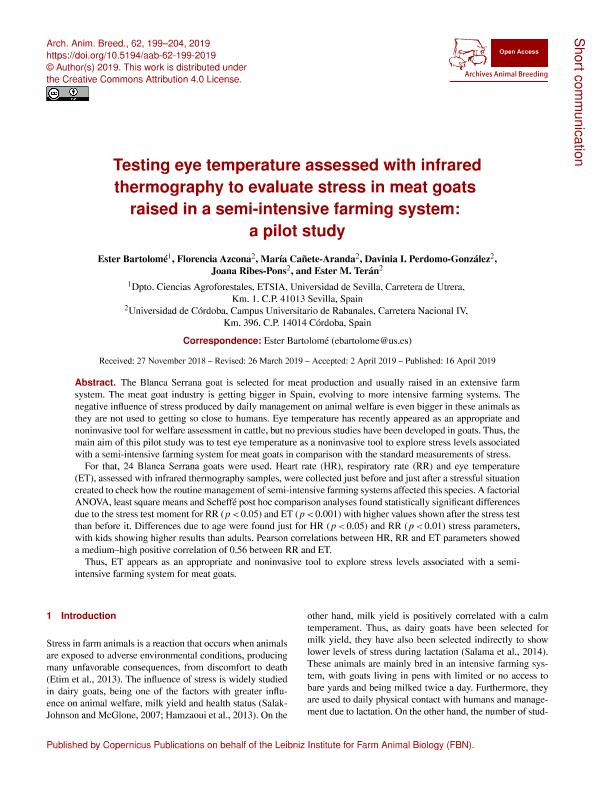Mostrar el registro sencillo del ítem
dc.contributor.author
Bartolomé Medina, Ester

dc.contributor.author
Azcona, Florencia

dc.contributor.author
Cañete Aranda, María
dc.contributor.author
Perdomo González, Davinia Isabel

dc.contributor.author
Ribes Pons, Joana
dc.contributor.author
Teran, Ester Mercedes

dc.date.available
2021-02-18T20:38:08Z
dc.date.issued
2019-04-16
dc.identifier.citation
Bartolomé Medina, Ester; Azcona, Florencia; Cañete Aranda, María; Perdomo González, Davinia Isabel; Ribes Pons, Joana; et al.; Testing eye temperature assessed with infrared thermography to evaluate stress in meat goats raised in a semi-intensive farming system: A pilot study; Archiv Fur Tierzucht; Archiv für Tierzucht; 62; 1; 16-4-2019; 199-204
dc.identifier.issn
0003-9438
dc.identifier.uri
http://hdl.handle.net/11336/126016
dc.description.abstract
The Blanca Serrana goat is selected for meat production and usually raised in an extensive farm system. The meat goat industry is getting bigger in Spain, evolving to more intensive farming systems. The negative influence of stress produced by daily management on animal welfare is even bigger in these animals as they are not used to getting so close to humans. Eye temperature has recently appeared as an appropriate and noninvasive tool for welfare assessment in cattle, but no previous studies have been developed in goats. Thus, the main aim of this pilot study was to test eye temperature as a noninvasive tool to explore stress levels associated with a semi-intensive farming system for meat goats in comparison with the standard measurements of stress. For that, 24 Blanca Serrana goats were used. Heart rate (HR), respiratory rate (RR) and eye temperature (ET), assessed with infrared thermography samples, were collected just before and just after a stressful situation created to check how the routine management of semi-intensive farming systems affected this species. A factorial ANOVA, least square means and Scheffe post hoc comparison analyses found statistically significant differences due to the stress test moment for RR (p<0:05) and ET (p<0:001) with higher values shown after the stress test than before it. Differences due to age were found just for HR (p<0:05) and RR (p<0:01) stress parameters, with kids showing higher results than adults. Pearson correlations between HR, RR and ET parameters showed a medium-high positive correlation of 0.56 between RR and ET. Thus, ET appears as an appropriate and noninvasive tool to explore stress levels associated with a semiintensive farming system for meat goats.
dc.format
application/pdf
dc.language.iso
eng
dc.publisher
Archiv Fur Tierzucht

dc.rights
info:eu-repo/semantics/openAccess
dc.rights.uri
https://creativecommons.org/licenses/by/2.5/ar/
dc.subject
INFRARED
dc.subject
THERMOGRAPHY
dc.subject
EYE
dc.subject
STRESS
dc.subject.classification
Ciencias Veterinarias

dc.subject.classification
Ciencias Veterinarias

dc.subject.classification
CIENCIAS AGRÍCOLAS

dc.title
Testing eye temperature assessed with infrared thermography to evaluate stress in meat goats raised in a semi-intensive farming system: A pilot study
dc.type
info:eu-repo/semantics/article
dc.type
info:ar-repo/semantics/artículo
dc.type
info:eu-repo/semantics/publishedVersion
dc.date.updated
2020-11-18T16:19:09Z
dc.journal.volume
62
dc.journal.number
1
dc.journal.pagination
199-204
dc.journal.pais
Alemania

dc.journal.ciudad
Dummerstorf
dc.description.fil
Fil: Bartolomé Medina, Ester. Universidad de Sevilla; España
dc.description.fil
Fil: Azcona, Florencia. Universidad de Córdoba; España. Consejo Nacional de Investigaciones Científicas y Técnicas; Argentina
dc.description.fil
Fil: Cañete Aranda, María. Universidad de Córdoba; España
dc.description.fil
Fil: Perdomo González, Davinia Isabel. Universidad de Córdoba; España
dc.description.fil
Fil: Ribes Pons, Joana. Universidad de Córdoba; España
dc.description.fil
Fil: Teran, Ester Mercedes. Universidad de Córdoba; España. Consejo Nacional de Investigaciones Científicas y Técnicas; Argentina
dc.journal.title
Archiv für Tierzucht

dc.relation.alternativeid
info:eu-repo/semantics/altIdentifier/url/https://www.arch-anim-breed.net/62/199/2019/
dc.relation.alternativeid
info:eu-repo/semantics/altIdentifier/doi/https://doi.org/10.5194/aab-62-199-2019
Archivos asociados
